Abstract
With the growing consumer demand in the electronics field, sustainable and effective cooling approaches are imperative to maximize operational efficiency. Heat pipes shave a major consideration in the field of heat transfer in a modern era of miniaturization of equipment. In current trends, the proportion of custom-designed electronic chips is increasing, given the space constraints of the application. Additionally, the use of nanofluids in heat pipes has drawn considerable attention because of their exceptional performance in heat transfer. This research is proposed primarily to investigate the effect of nanofluids on the performance of the partially flattened heat pipe. Here, the evaporator portion forms flat shape which is mostly suitable for fixing easily in electronic circuits. The remaining portions, such as the adiabatic and condenser, are left as circular. This work also covers the development of flattened heat pipes and analyzes their performance. Pure water, Titanium Oxide (TiO2), and Aluminum Oxide (Al2O3)-water-based nanofluids have been used in this research as working fluids. The heat transfer analysis on the customized partially flattened heat pipe was performed, and the results have been compared with fully flattened and circular heat pipes. The heat transfer parameters, such as the heat transfer coefficient and thermal resistance, have been determined from the heat input, evaporator temperature, and condenser temperature for various inclination angles including 0°, 45°, and 90° with the heat input varied between 50–300 W. The results have shown that the flattened heat pipe performed better with Al2O3 nanofluid at an inclination angle of 45° at all of the heat inputs and provided better thermal resistance compared with the other combinations. At 45°, the resistance of the heat pipe was reduced by 2% and 8% with Al2O3 nanofluid compared with water and TiO2 nanofluid. Furthermore, the heat transfer coefficient was found higher by 4 W/m2-K and 4.6 W/m2-K with Al2O3 and gives better results in terms of resistance and heat transfer coefficient.
1. Introduction
Electronic applications are omnipresent and they are expected to increase given the pace of digitalization. Electronic devices often require a cooling system for prolonged operation with high efficiency. However, a sustainable, compact and effective cooling system is preferred for electronic applications. A heat pipe is one of the most efficient and reliable heat conducting devices that use liquid-to-vapor conversion as well as the related heat transfer from the hot region to the cold region by relative fluid flow. This heat pipe concept was invented by Gauglerin 1942 at the Los Alamos National Laboratory [1]. It is mainly applicable in various sectors such as electronic device cooling, renewable energy exploitation, spacecraft temperature equalization, etc., because of its excellent heat transfer performance [2,3]. Based on their operation, the heat pipes are classified as wick-loop heat pipes, heat pipes, oscillating heat pipes, thermosyphon, etc., being normally used. Each heat pipe type has unique properties in terms of construction and shape. Among these, the wick heat pipe is chosen because of its flexibility and structural simplicity, as well as wide usage [4,5]. It is also capable of working against gravity. The working fluid within the heat pipe can circulate due to the capillary force induced by the wick structure, which allows the heat pipe to work in any orientation [6]. A wick heat pipe is made out of a sealed container of any wick structure [7]. Similarly, there are several types of wick structures that can be employed within the heat pipe, and they are commonly categorized as mesh, composite, grooved, and powder wicks [8].
Flattened heat pipes have wider applications in the sustainable thermal management of electronic equipment due to their excessive thermal conductivity and rapid thermal response similar to the circular heat pipe [9]. Mostly, the electronic circuits are in a flat shape, where flattened heat pipes are easily fixed on their surfaces [10]. The inference from the previous research indicates that the heat pipe provides poor thermal resistance performance when a high filling ratio is employed [11]. The heat pipes are constructed with copper to support large heat transfer through narrower spaces, over long distances, and within lower temperature gradient [12]. Long heat pipes can have an effective thermal conductivity that is closer to 100 kW/(m·K) than copper, which has a thermal conductivity of about 0.4 kW/(m·K) [13]. Special fluid, such as Williamson fluid, has been used as working fluid for heat transfer applications [14]. The nanofluids are a promising working fluid that can enhance heat transfer more effectively than other working fluids by improving the thermal conductivity of working fluids [15]. Nanofluids such as Al2O3, CuO, TiO2, and Si are ideal coolants mostly used for heat transfer devices such as heat exchangers, electronic cooling, and radiators [16]. The copper nanoparticle sintered heat pipe performs better with a 45° orientation than other angles [17]. The silver nanofluids perform better when the particle size is under 200 nm with cylindrical and flat plate heat pipe [18]. Among Al2O3, CuO, and ZnO nanofluids with 1wt% concentration with DI water in a cylindrical heat pipe, the CuO nanofluids perform better at 60° orientation as compared with others [18].
From various research findings, it can be observed that the use of nanofluids at 0.1wt percent concentration gives better results [19]. Furthermore, the modification of heat pipe geometry without compromising heat transfers another challenging task. The adiabatic section of long Two Phase Closed Thermosiphon (TPCT) was modified by convergent and divergent sections, and it performed better with a 45° inclination angle than normal TPCT. This was mainly due to reduced pressure drop, lower fluid accumulation and better interaction forces with the convergent and divergent sections. The 2% enhancement of heat transfer with modified TPCT was confirmed due to flow pattern changes [20]. Furthermore, the TPCT is an efficient approach to transferring a significant quantity of heat in a small size for a long distance [21]. Most TPCTs have the evaporator section at the bottom for maximum utilization of the gravitational force. Because of its small size and design flexibility, TPCT is employed as the most suitable heat transfer equipment in several cooling applications such as electronics, solar units, and aircraft [22]. Many studies have been conducted to improve heat transfer by adjusting various parameters, including heat input power, working fluid used, fluid filling ratio, and orientation angles [23,24,25,26]. Additionally, the application of both circular and flat plate heats is extended to construction industries where large-scale heat pipes are fitted on roofs and walls to maintain the required room temperature [24]. This will reduce the requirement for air conditioners, which leads to a sustainable way of room cooling [25].
To the best of authors’ knowledge, there is no research study investigating the energy performance of partially flattened heat pipes for sustainable electronic cooling applications. The flattened portion is the evaporator, and the circular portion is the condenser and adiabatic section; it is designed such that the flattened portion can easily insert into electronic chips (evaporator) and the remaining portions of the adiabatic section and condenser could be placed outside of the system. The remaining circular portion can follow the regular flow pattern, which helps to enhance the heat transfer in a better manner. This approach can improve the thermal performance of the heat pipe more than fully flatted heat pipes. This research mainly focuses on organizing the effect of nanofluids such as TiO2 and Al2O3 on the performance of the partially flattened heat pipe. This work also covers the design and development of flattened heat pipes for assessing energy performance. Pure water, TiO2, and Al2O3 nanofluids are considered as working fluids in this research. To determine the heat transfer parameters, such as thermal resistance and heat transfer coefficient, the experiment was performed with different inclination angles including 0°, 45°, and 90° with the heat input ranging from 50 to 300 W.
2. Materials and Methods
Due to profile changes in this partially flattened portion of heat pipe, the pressure drop due to wall friction is reduced slightly, thereby improving the thermal performance of heat pipe. The width of the flattened portion of heat pipe is 25 mm and the height is 10 mm, the length of the evaporator and the condenser are 150 mm, and the adiabatic segment is around 50 mm in length. The temperature distribution of flattened heat pipes is obtained by the use of K-type thermocouples. The thermocouples are connected to a personal computer through a data logger for storage and data verification. Furthermore, the fixed water flow rate to the condenser of 5 mL/s and filling proportion of 35% is used in this research which is compared with [20], where testing was performed in similar conditions. The inlet temperature of the water was maintained at 19 °C to the condenser jacket and outlet water temperature was varied based on different heat inputs. The flattened and sectioned copper tube with the required shape and size was purchased and for the joining and closing of both of the ends gas weld was used. A heater coil with a capacity of 800 W was fixed with a proper bonding solution. The condenser is made of Acrilyte materials with a water inlet and outlet portion, and it was fitted on the condenser portion of the heat pipe. The fixing paste was used to fix the condenser to prevent water leakage. In total, 10 thermocouples were used to measure temperatures at various locations. After vacuuming the heat pipe with a vacuum pump, the heat pipe was filled with the working fluid with the required filling ratio. A helium leak detector was used to detect leakage in the heat pipe.
The partially flattened heat pipe test rig is shown in Figure 1. The size of the condenser section is 22 mm in inner diameter, and 24 mm in outer diameter. The width of the evaporator is 20 mm with a wall thickness of 2mm and height is 10 mm. Additionally, the used wick is a Copper 100 mesh type, with a porosity of 0.63 and a thickness of each layer of 0.16 mm; in total 4 layers were used with thickness of 0.64 mm. The test was conducted in three different orientations such as 0°, 45°, and 90°. In 45° and 90°, the evaporator is placed under the condenser. The glass wool is used as the insulating material to cover the heating surface of the pipe, except for the condenser. To validate the present partially flattened heat pipe, the fully circular and fully flatted heat pipes were developed and tested at similar conditions. The results have been compared at the end of the Results and Discussion section. The dimension of the circular heat pipe is 24 mm outer diameter with wall thickness of 2 mm, and the lengths of portions are 150 mm, 50 mm, and 150 mm for evaporator, adiabatic, and condenser section of both circular and fully flattened heat pipes. The cross section of fully flattened heat pipe is 20 mm width with 2 mm wall thickness. Moreover, water-based Al2O3 and TiO2 Nanofluids have been used as working fluid for the above set-up. The nanofluids have been prepared using an ultrasonic mixer with high shear conditions (Make Labman, 20 kHz, AC 220 V/50 Hz with probe diameter 9.5 mm) shown in Figure 2. Both Al2O3 and TiO2 nanoparticles have been mixed with the proportions of 2 wt%. In addition, the structure of the partially flattened heat pipe is shown in Figure 3. The length of the evaporator and the condenser are 150 mm (refer to Figure 3b). The nanoparticle deposition depends on the suspension rate of the nanoparticles. The nanoparticle suspension rate has been analyzed by keeping the nanofluid in the beaker for seven days, and deposition was checked visually every day. After seven days, the fluid was transferred to another beaker and the nanoparticle deposition on the walls was checked. TiO2 nanoparticles have been found to have a higher tendency on deposition than Al2O3 nanoparticles. The SEM results show the nanoparticle deposition on the wall; the TiO2 has deposited more than Al2O3; it may increase the walls thickness which, in turn, may cause reduction in heat transfer.
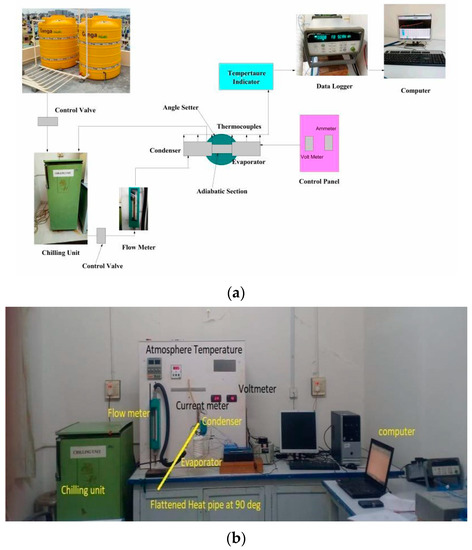
Figure 1.
Schematic layout (a) and Photograph (b) of Experimentation.
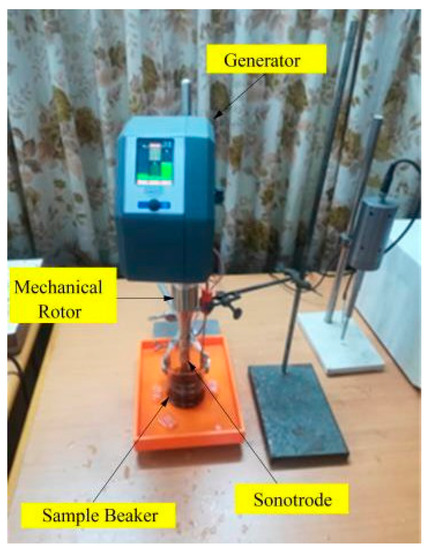
Figure 2.
Sonicator for nanofluid preparation.
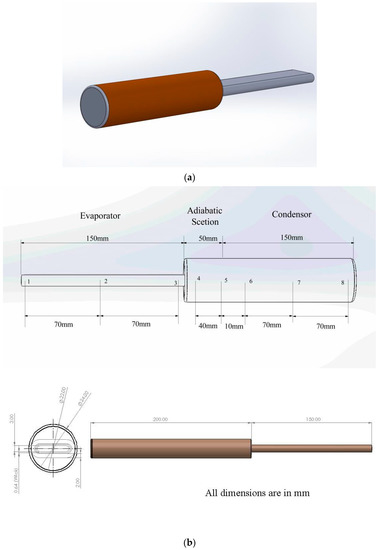
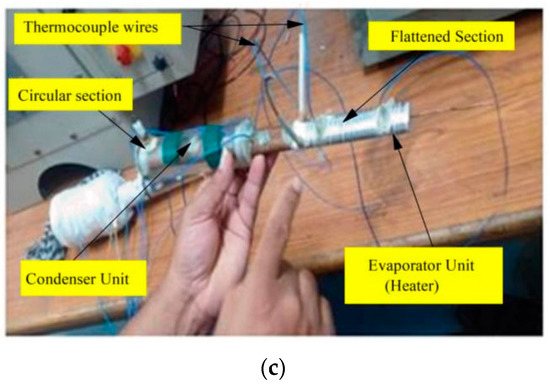
Figure 3.
Partially flattened heat pipe. (a) 3D View of flattened heat pipe. (b) Thermocouples positions and size of the heat pipe (c) Photograph of flattened heat pipe before insulation.
Eight K Type thermocouples were used to monitor the temperature change of the flattened heat pipe, as shown in Figure 3b. Among these points, thermocouples 1–3 were used to measure the temperature in the evaporation section, 4–5 were used to measure the temperature in the adiabatic section, and 6–8 were used to measure the temperature in the condenser section. One Hz sampling rate was used in the collection of temperature data by computers and data acquisition equipment. The K-type thermocouples are normally used to calculate the temperatures with an error of ±0.3 °C. The rotameter was used for measuring the cooling water flow rate in the condenser with an error of ±0.1 mL/s. The digital power meter was used to measure the heating power meter with an uncertainty of ±1% FS. The experiment reaches a steady state after 10 min, with a temperature less than 0.5 °C. The experimental procedures were carried out for heat pipes for varied input heating powers with TiO2 and Al2O3 nanofluids, separately. The results of the heat pipes using nanofluids have been compared with those of the heat pipe using water as a working fluid. Figure 3c shows the positions of the heater around the evaporator, adiabatic section before insulation and acrylic condenser around the condenser section of the heat pipe. The Adiabatic condition has been maintained by insulating the glass wool insulation tape with 0.5-inch thickness. Dry-out conditions occurred in 400 W and 450 W for water and the other two nanofluids.
2.1. Aluminium Oxide
The size of the nanoparticle varies between 30 nm and 70 nm. Depending on the values of surface tension and viscosity, the thermal conductivity of Al2O3-water nanofluids improves with the increase of volume concentration and temperature and the decrease of average particle size. The increase in volume concentration improves the saturation vapor pressure of Al2O3-water-based nanofluids, whereas it decreases the latent heat of vaporization. The SEM image of Al2O3 is shown in Figure 4. The specification of Al2O3 nanoparticles is given in Table 1.
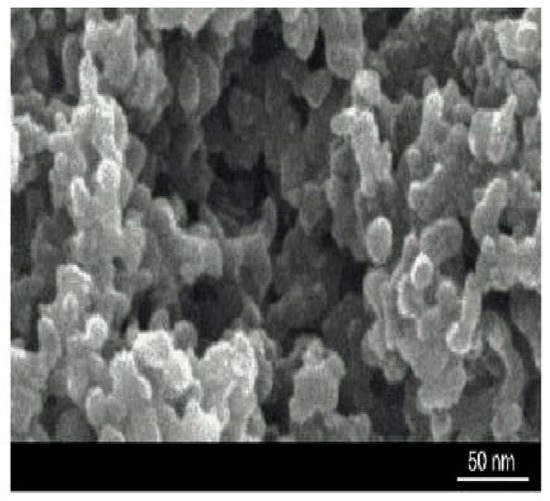
Figure 4.
SEM image ofAl2O3.

Table 1.
Properties of Al2O3.
2.2. Titanium Oxide
The size of the particle varies between 30 nm and 70 nm. Generally, TiO2 nanofluids perform efficiently due to their high thermal conductivity when compared with water and other fluids. The SEM image of TiO2 is shown in Figure 5. The specifications of TiO2 nanoparticles are given in Table 2. The Physical properties of nanofluid are provided in Table 3. Additionally, Table 4 shows the design of experiments which indicates the parameters changed for making the various tests.
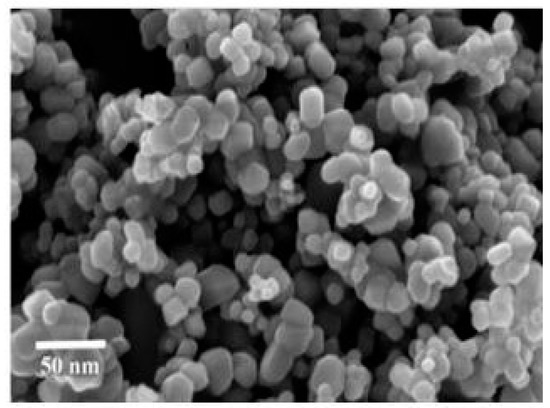
Figure 5.
SEM image of TiO2.

Table 2.
Properties of TiO2.

Table 3.
Physical Properties of Nanofluids.

Table 4.
Experimental parameter conditions.
2.3. Error and Uncertainty Assessment
The filling ratio of 35% is fixed as optimal and the water flow rate to the condenser is selected as 300 mL/min. These parameters are selected from previous investigations [20].
where, q = Heat flux in kW/m2. Δq = Difference in heat flux kW/m2. Q = Heat transfer rate in W. h = Heat transfer Coefficient W/m2K. Δh = Difference in heat transfer Coefficient W/m2K. R = Resistance °C/W. ΔR = Difference in Resistance °C/W.
At a lower heat input, the uncertainties for thermal resistance, heat flux, and coefficient of heat transfer are less than 5.8%. Moreover, at increasing heat input, it is decreased to 3.2%. Furthermore, a few limits such as dry out, counter flow, flooding, and boiling restrictions, are observed during heat pipe operation. Dry out and counter flow restrictions are significant constraints. The dry-out conditions are indicated by the rapid increase in the evaporator temperature.
2.4. Heat Transfer Parameters
The heat transfer coefficient for the evaporator and the condenser have been calculated using Equations (4) and (5), respectively,
where he & hc—Heat transfer coefficient in the evaporator and condenser section. qe & qc—Heat flux in the evaporator and condenser section.
where m = mass flow rate in kg/s. Cp = Specific heat capacity of water in kJ/kg·K. Tout = Outlet water temperature in °C. Tin = Inlet water temperature in °C. d = Diameter of the Condenser section in m. lc = Length of the condenser section in m. Ta, Tc, Te—Average Temperature in the adiabatic, condenser, and evaporator section after reaching the steady state conditions.
qe = Qin/Perimeter of the flattened section
Qin—Heat Input
Qout = Amount of heat transferred in the condenser section
Qin—Heat Input
Qout = Amount of heat transferred in the condenser section
Qout = ṁCp (Tout − Tin)
The below-mentioned Equation (6) is used to obtain an overall thermal resistance.
where Rt—Total thermal resistance °C/W. Qe—Amount of heat transferred in the evaporator section in W.
The thermocouples are fixed at the outer surface of the heat pipe, because fixing of thermocouple inside the evaporator requires drilling the surfaces. So, this may lead to difficulty in making the heat pipe leakproof. The radial temperature drop is considered as minimum and it was neglected in calculations.
3. Results and Discussion
The partially flattened heat pipe using TiO2 and Al2O3 nanofluids have been tested in different heat inputs. Experiments were carried out at different inclination angles such as 0°, 45°, and 90° at different heat inputs ranging from 50 to 300 W. The thermal conductivity and heat transfer resistance have been discussed and evaluated using several input parameters. Thermal resistance was slightly affected by different inclination angles. Figure 6, Figure 7 and Figure 8 indicate that higher thermal resistance is obtained at low heat input than higher heat input. The heat transfer of the heat pipe also relies on heat input. At the lower heat input, the presence of a large quantity of liquid pools in the evaporator is the major reason for the higher resistance. It gives more thermal resistance than vapor presence. Moreover, the highest thermal resistance is observed at 90° inclination. The vaporization rate is lower at 90° with a reduced heat input level, and the condensed fluid is received quickly by the evaporator due to gravity assistance, which causes more water to be accumulated at the evaporator. This increases the temperature of the evaporator and resistance. This implies that all of the liquids accumulate at the bottom of the evaporator in the heat pipe, which greatly increases the thermal resistance. A significantly sized air gap is present at 45° inclination at the evaporator portion due to the filling ratio of 35%. The resistance has been found to be slightly higher with the inclination angle of 0° when compared with 45°. This is related to the lack of gravity-assisted fluid circulation within the heat pipe in a horizontal position. Normally, the heat pipe is operated with higher fluid flow resistance at the horizontal orientation, which may cause a slight enhancement in thermal resistance. The fluid resistance at the wall and between the liquid vapor film separations is reduced at a 45° inclination angle due to the influence of gravity and the air gap at the bottom of the evaporator section. Therefore, the heat pipe performs better with the inclined angle of 45° than the other two inclination angles. The thermal resistance greatly depends on the variation of the average evaporator and condenser shapes. The difference between the average evaporator and condenser temperatures strongly influences the thermal resistance. Heat is transferred from the source to the evaporator and then to the working fluid; the geometrical changes will have a great impact on the evaporator temperature. It is due to the changes happening in the flow pattern which leads to either enhancement or reduction in thermal performance. Similarly, the thermal resistance of heat pipe with Al2O3 nanofluid is found to below as compared with TiO2 nanofluid and water. This is mainly due to the higher thermal conductivity found with Al2O3 nanoparticles than that of TiO2 nanofluids and water. The resistance of Al2O3 nanofluid has been found lower up to 0.13 °C/W and 0.24 °C/W than that of TiO2 nanofluid and water at horizontal orientation with 50W. The differences during high heat input have been found lower, due to the lower quantity of liquid pool in the evaporator. Comparing the resistance in different orientations, the resistance with 45° has been found lower up to 0.3°/W and 0.4°/W than 0° and 90°.
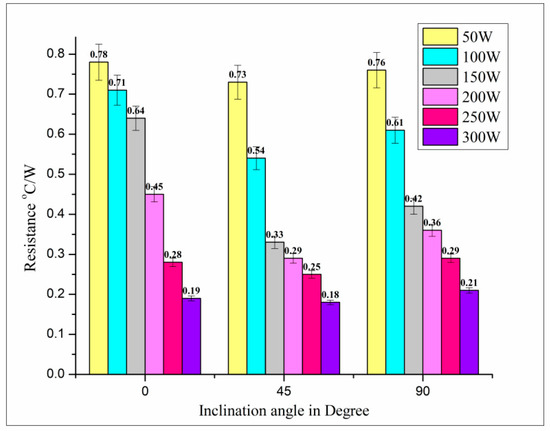
Figure 6.
Resistance with water vs. Inclination angle.
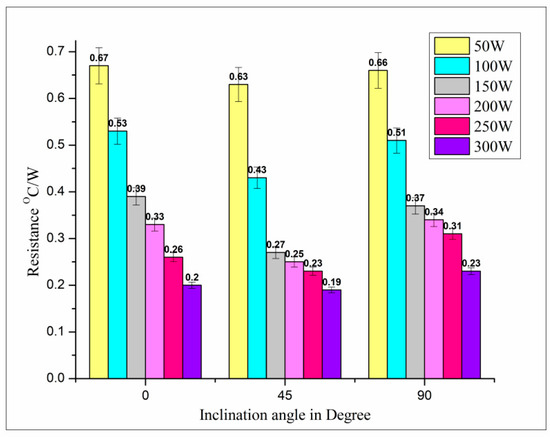
Figure 7.
Resistance with TiO2 vs. Inclination angle.
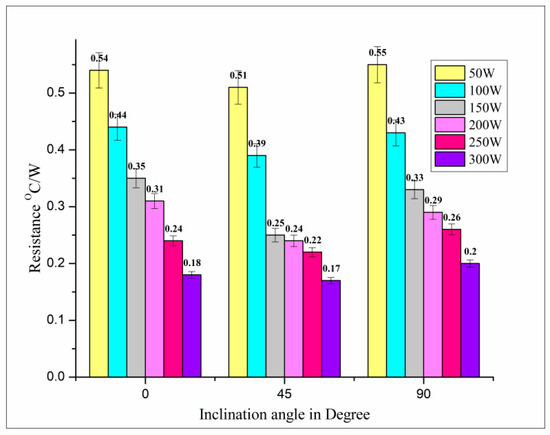
Figure 8.
Resistance with Al2O3 vs. Inclination angle.
Figure 9, Figure 10 and Figure 11 indicate that the heat transfer coefficient of water, TiO2, and Al2O3 have gradually increased with the increase of heat flux at the respective positions, such as horizontal, inclined, and vertical. In general, a smoother surface improves drop wise condensation, which raises the heat transfer coefficient. At the same time, the nucleate boiling and the heat transfer coefficient are both improved by the rough surface formed in the evaporator. Variations in heat resistance are the main reason for the increase and decrease in heat transfer coefficient values. In addition, the heat transfer coefficient of Al2O3 is higher than that of water and TiO2. The heat resistance with Al2O3 has been found to be low as compared with TiO2 nanofluid and water; this is due to Al2O3 enhancing the nucleate boiling in the evaporator [24]. Also, the 45° inclination has a good tendency in yielding better evaporation and collecting back the condensed liquid to the evaporator [18]. The heat transfer coefficient has been found higher, up to 4 W/m2-K and 4.6 W/m2-K, with Al2O3 than TiO2 and water. This is due to the lower heat resistance value. Comparing the heat transfer coefficient in different orientations, the heat transfer coefficient with 45° has been found higher than 0° and 90°.
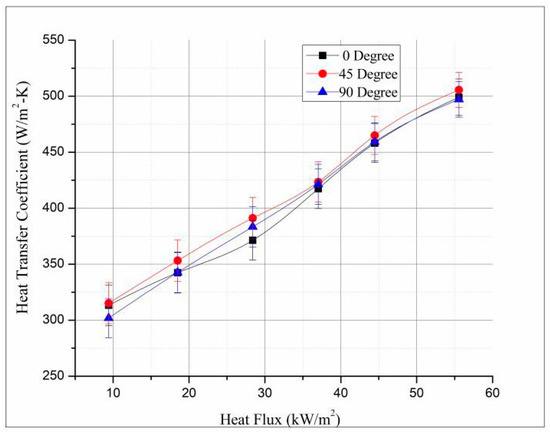
Figure 9.
Heat transfer coefficient of water at horizontal, inclined, and vertical positions.
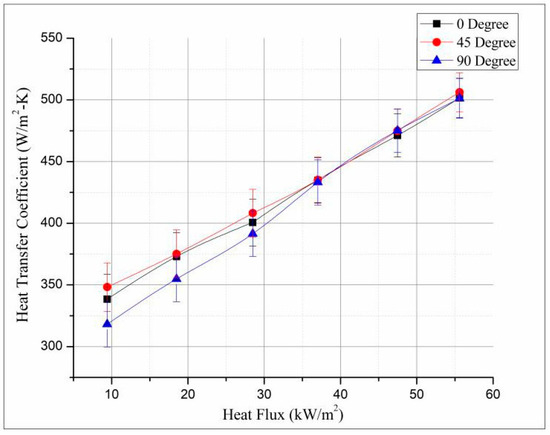
Figure 10.
Heat transfer coefficient of TiO2 at horizontal, inclined, and vertical positions.
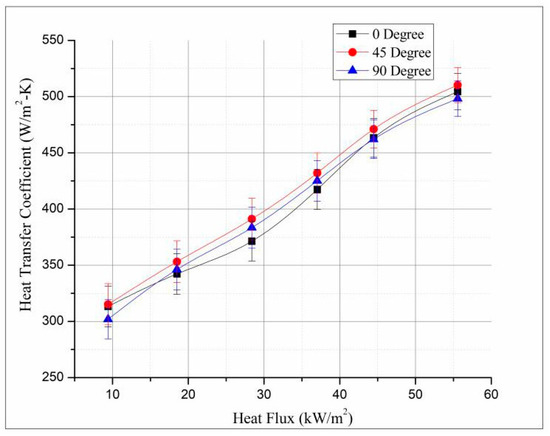
Figure 11.
Heat transfer coefficient of Al2O3 at horizontal, inclined, and vertical positions.
The temperature distributions for the various places in the heat pipe under different inclination angles such as 0°, 45°, and 90° are shown in Figure 12, Figure 13 and Figure 14, respectively. The temperature at the evaporator wall with TiO2 nanofluid is found to be a little higher when compared with Al2O3 nanofluid in all orientations. This indicates that Al2O3 nanofluids have a better tendency to transfer heat than TiO2 nanofluids and water. This has occurred due to the thermal resistance with grade of Al2O3 ≥ TiO2 ≥ water. At 45°, it enhances fluid circulation and improves the vapor pressure between the evaporator section and the condenser section. The other two orientations are not adequate for both thermal operations for this shape changed heat pipe. The pressure drop and acceleration are instigated because of the shape changes. The increased frictional factor partially countered the improved heat transfer since the fluid flows in a narrow diametrical path. Due to the sudden expansion and produced turbulence in the flow when the accelerated fluid hits the circular section, the temperature marginally decreases and it reduces the pressure drop partially. As a result, the temperature decreases, whereas the rate of heat transfer increases close to the condenser section. Among three working fluids, the Al2O3 has been found to have better temperature distribution at the condenser and the evaporator walls, which confirms better heat transfer from the evaporator portion to the condenser portion, as shown in Figure 9, Figure 10 and Figure 11.
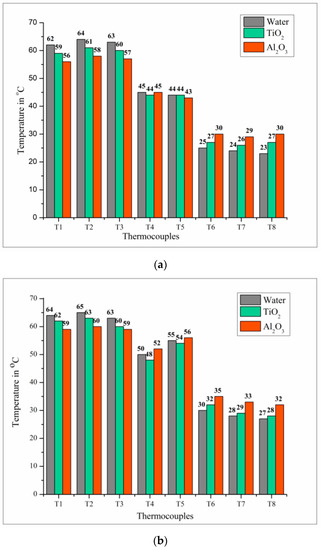
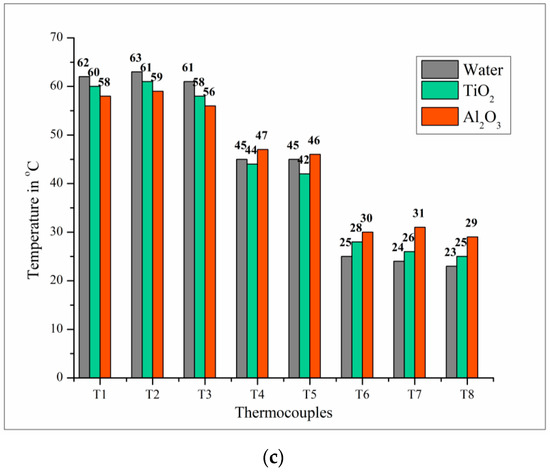
Figure 12.
Heat input of 50 W. (a) At Horizontal. (b) At Inclined. (c) At Vertical.
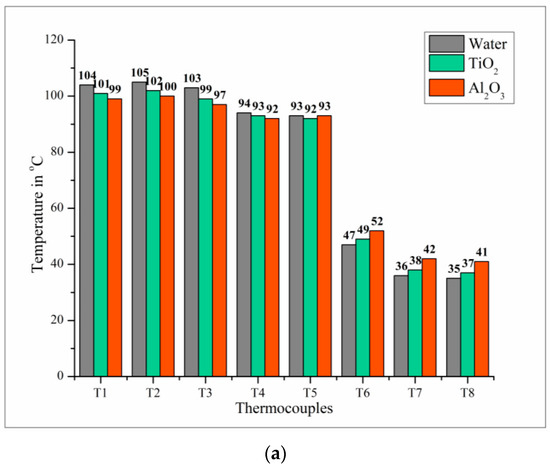
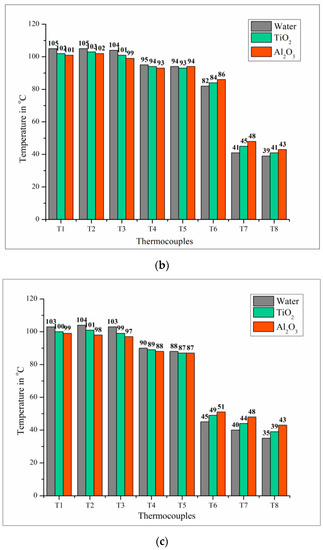
Figure 13.
Heat input of 150 W. (a) At Horizontal. (b) At Inclined. (c) At Vertical.
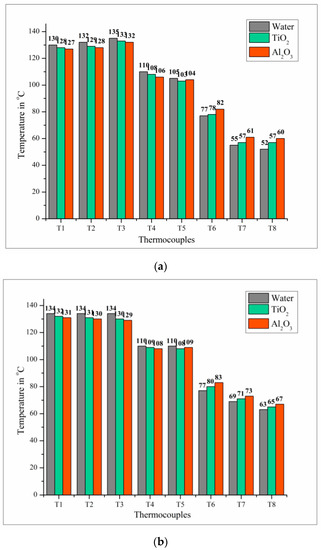
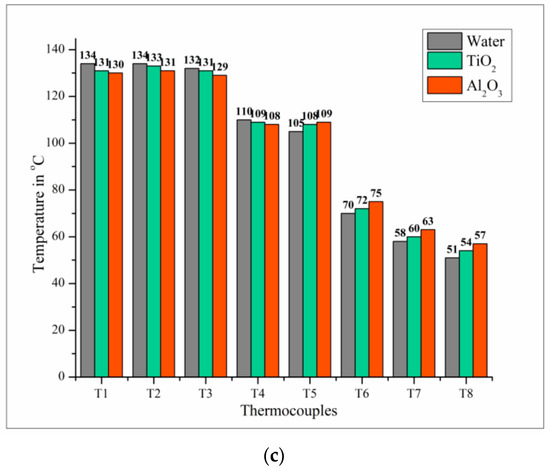
Figure 14.
Heat input of 250 W. (a) At Horizontal. (b) At Inclined. (c) At Vertical.
Table 5 gives the comparisons of the thermal performance of the partially flattened, fully flattened, and circular heat pipes. The fully flattened heat pipe gives better performance compared with the other two, for a resistance of 0.48 °C/W and heat transfer coefficient of 720 W/m2-K. This is observed because it has no obstacles in the flow regime and it follows the regular flow patterns, which leads to a good heat transfer coefficient. However, a partially flattened heat pipe does not follow the regular flow patterns and it has high pressure drop, which results because of a low heat transfer coefficient rather than a fully flattened heat pipe. Moreover, the partially flattened heat pipe reduces the pressure drop by shape changes, and also it follows the regular flow patterns in the condenser which cause the enhancement of thermal performance with a value of 0.51 °C/W in resistance and 685 W/m2-K of heat transfer coefficient. In a regular heat pipe, the pressure drop is higher than in the other two heat pipes, which causes higher resistance. At a 45° orientation with a heat input of 150 W, the temperature distributions are higher by up to 4.6% than the regular circular heat pipe, whereas lower by up to 2.3% than the fully flattened heat pipe.

Table 5.
Comparison with regular circular heat pipe and fully flattened heat pipe.
Figure 15 shows the SEM images of the heat pipe inner wall for both TiO2 and Al2O3 operations. At the evaporator, more and denser particle deposition with TiO2 nanofluids observed than in Al2O3 operation. It increases the wall thickness unevenly, which reduces the heat transfer with TiO2 nanofluids than Al2O3. Similarly, more particle deposition in TiO2 nanofluid has been found with a condenser; this is also a reason to reduce the heat transfer to the condenser. Low particle deposition has been found with Al2O3 operation in both the evaporator and the condenser.
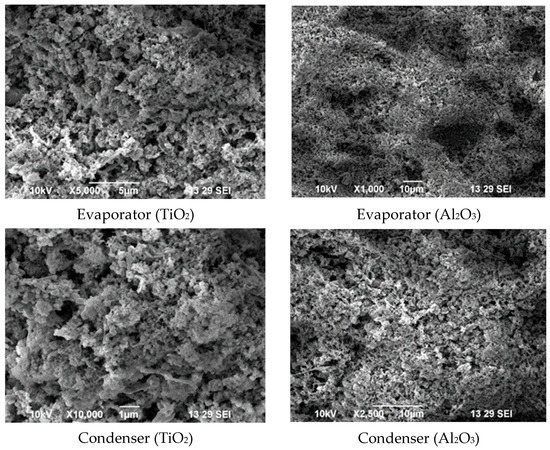
Figure 15.
SEM images of the inner wall of the evaporator.
4. Conclusions
Partially flattened heat pipes were studied in this research. The water-based Al2O3 and TiO2 nanofluids were used with a 35 vol% filling ratio. This study was carried out at a heat input ranging from 50 to 300 W for inclination angles including 0°, 45°, and 90°.
- The thermal resistance with Al2O3 was found lower by up to 0.02 °C/W and 0.08 °C/W than TiO2 nanofluid and water at a 45° orientation in a partially flattened heat pipe operation.
- The heat transfer coefficient was found to be higher by up to 4 W/m2-K and 4.6 W/m2-K with Al2O3 nanofluid than TiO2 and water at 45° orientation in a partially flattened heat pipe operation.
- The partially flattened heat pipe exhibited better performance in terms of better heat transfer coefficient and low thermal resistance than a fully flattened heat pipe.
- The SEM images describe a little higher particle deposition with TiO2 operation than with Al2O3 operation.
The designed heat pipe, with a partially flattened configuration, would unfold numerous applications in electronics cooling for efficient energy usage, paving a way for sustainable development of technologies.
Author Contributions
Writing-original draft preparation, Conceptualization, Formal analysis, Investigation, Visualization, S.R.; Conceptualization, Formal analysis, Investigation, Data curation, R.R.V.R.; Formal analysis, Data curation, Writing-Review and editing, R.M.E.; Writing-review and Editing, P.K. All authors have read and agreed to the published version of the manuscript.
Funding
This research received no external funding.
Institutional Review Board Statement
Not applicable.
Informed Consent Statement
Not applicable.
Data Availability Statement
Not applicable.
Conflicts of Interest
The authors declare no conflict of interest.
Abbreviations
| SEM | Scanning Electron Microscopy |
| Al2O3 | Aluminum Oxide |
| TiO2 | Titanium Oxide |
| CuO | Copper Oxide |
| ZnO | Zinc Oxide |
| TPCT | Two-Phase Closed Thermosiphon |
| PV | Photovoltaic panels |
References
- Reay, D.; Kew, P.; McGlen, R. Heat Pipes—Theory, Design and Applications, 6th ed.; Elsevier Ltd.: Oxford, UK, 2014. [Google Scholar]
- Huang, D.S.; Chen, T.C.; Tsai, L.T.; Lin, M.T. Design of fins with a grooved heat pipe for dissipation of heat from high-powered automotive LED headlights. Energy Convers. Manag. 2019, 180, 550–558. [Google Scholar] [CrossRef]
- Wang, X.Y.; Fan, H.T.; Zhu, Y.Z.; Zhu, M.Z. Heat transfer simulation and analysis of ice and snow melting system using geothermy by super-long flexible heat pipes. Energy Procedia 2017, 105, 4724–4730. [Google Scholar] [CrossRef]
- Bai, L.; Lin, G.; Zhang, H.; Miao, J.; Wen, D. Operating characteristics of a miniature cryogenic loop heat pipe. Int. J.Heat Mass Transf. 2012, 55, 8093–8099. [Google Scholar] [CrossRef]
- Reay, D.; Kew, P. Heat Pipe, 5th ed.; Elsevier: Amsterdam, The Netherlands, 2006. [Google Scholar]
- Cen, J.; Li, F.; Li, T.; Huang, W.; Chen, J.; Jiang, F. Experimental study of the heat transfer performance of an extra-long gravity- assisted heat pipe aiming at geothermal heat exploitation. Sustainability 2021, 13, 12481. [Google Scholar] [CrossRef]
- Chen, M.M.; Faghri, A. An analysis of the vapor flow and the heat conduction through the liquid-wick and pipe wall in a heat pipe with single or multiple heat sources. Int. J. Heat Mass Transf. 1990, 33, 1945–1955. [Google Scholar] [CrossRef]
- Faghri, A. Heat Pipe Science and Technology; Taylor and Francis: Abingdon, UK, 1995. [Google Scholar]
- Hanzhong, T.; Zhang, H.; Zhuang, J.; Bowmans, J.W. Experimental study of partially flattened axial grooved heat pipes. Chin. Sci. Bull 2008, 53, 3058–3072. [Google Scholar] [CrossRef]
- Kim, H.J.; Lee, S.H.; Kong, Y.C. Long-term reliability of the thermal performance of a flat-plate heat pipe using a prognostics method. Int. J. Heat Mass Transf. 2015, 82, 369–372. [Google Scholar] [CrossRef]
- Zhang, B.; He, Z.; Wang, W.; Wang, J.; MikulčićJiří, H.; Klemeš, J. Investigation on the thermal performance of flat-plate heat pipes with various working fluids under different inclination angles. Energy Rep. 2022, 8, 8017–8026. [Google Scholar] [CrossRef]
- Faghri, A.; Zhang, Y.W. Transport Phenomena in Multiphase Systems; Elsevier Ltd.: Oxford, UK, 2006. [Google Scholar]
- Meseguer, J.; Pérez-Grande, I.; Sanz-Andrés, A. Spacecraft Thermal Control; Woodhead Publishing Limited: Cambridge, UK, 2012. [Google Scholar]
- Muhammad, I.A.; Muhammad, Z.; Bagh, A.; Fahd, J. Unsteady MHD Williamson Fluid with the Effect of Bioconvection over Permeable Stretching Sheet. Math. Probl. Eng. 2022, 2022, 7980267. [Google Scholar] [CrossRef]
- Soliman, A.S.; Xu, L.; Dong, J.; Cheng, P. Numerical Investigation of the Ribs’ Shape, Spacing, and Height on Heat Transfer Performance of Turbulent Flow in a Flat Plate Heat Exchanger. Sustainability 2022, 14, 15143. [Google Scholar] [CrossRef]
- Muhammad, I.A.; Usman, M.; Muhammad, M.K.; Baleanu, D.; Muhammad, T. Thermal transport with nanoparticles of fractional Oldroyd-B fluid under the effects of magnetic field, radiations, and viscous dissipation: Entropy generation; via finite Difference method. Open Phys. 2022, 20, 1216–1232. [Google Scholar] [CrossRef]
- Kumar, P.M.; Saminathan, R.; Tharwan, M.; Hadidi, H.; Stalin, P.M.J.; Kumaresan, G.; Ram, S.; Rinawa, M.L.; Saravanakumar, P.T.; Karthikeyan, K.; et al. Study on Sintered Wick Heat Pipe (SWHP) with CuO Nanofluids under Different Orientation. J. Nanomater. 2022, 2022, 7158228. [Google Scholar] [CrossRef]
- Chavda, N.; Bumataria, R. Effect of particle size and concentration on thermal performance of cylindrical shaped heat pipe using silver-DI water nanofluid. Int. J. Ambient. Energy 2022, 1–12. [Google Scholar] [CrossRef]
- Bumataria, R.; Chavda, N. Heat load and orientation impacts in cylindrical heat pipes using copper oxide, aluminium oxide, and zinc oxide nanofluids. Int. J. Ambient. Energy 2022, 43, 6273–6283. [Google Scholar] [CrossRef]
- Chandran, M.; Madurai Elavarasan, R.; Neelakandan, R.B.; Subramaniam, U.; Pugazhendhi, R. Influence of Geometrical Changes in an Adiabatic Portion on the Heat Transfer Performance of a Two-Phase Closed Thermosiphon System. Energies 2021, 14, 3070. [Google Scholar] [CrossRef]
- Porta-Gándara, M.A.; Fernández-Zayas, J.L.; Chargoy-del-Valle, N. Thermosiphon radiation capacity modelling for the cooling of dwellings. Case Stud. Therm. Eng. 2020, 21, 100724. [Google Scholar] [CrossRef]
- Ebaid, M.S.; Al-busoul, M.; Ghrair, A.M. Performance enhancement of photovoltaic panels using two types of nanofluids. Heat Transf. 2020, 49, 2789–2812. [Google Scholar] [CrossRef]
- Du, S.; Zhang, Q.; Hou, P.; Yue, C.; Zou, S. Experimental study and steady-state model of a novel plate loop heat pipe without compensation chamber for CPU cooling. Sustain. Cities Soc. 2020, 53, 101894. [Google Scholar] [CrossRef]
- Ho, C.J.; Hsu, H.-I.; Ho, T.-A.; Lai, C.-M. Thermal Performance of a Vertical U-Shaped Thermosyphon Containing a Phase-Change Material Suspension Fluid. Energies 2017, 10, 974. [Google Scholar] [CrossRef]
- Zhang, M.; Xie, Y.; Wang, Z. An Air Heat Tracing System of Firefighting Pipeline in Cold Region Highway Tunnel. Sustainability 2022, 14, 16056. [Google Scholar] [CrossRef]
- Tarigonda, H.; Shaik, D.P.M.D.; Reddy, D.R.R.; Reddy, G.V.S. Experimental Investigation on the Heat Pipe using Al2O3 and CuO Hybrid Nanofluid. Int. J. Thermophys. 2022, 43, 153. [Google Scholar] [CrossRef]
Disclaimer/Publisher’s Note: The statements, opinions and data contained in all publications are solely those of the individual author(s) and contributor(s) and not of MDPI and/or the editor(s). MDPI and/or the editor(s) disclaim responsibility for any injury to people or property resulting from any ideas, methods, instructions or products referred to in the content. |
© 2023 by the authors. Licensee MDPI, Basel, Switzerland. This article is an open access article distributed under the terms and conditions of the Creative Commons Attribution (CC BY) license (https://creativecommons.org/licenses/by/4.0/).